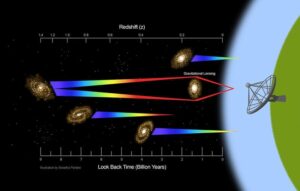Published on: January 18, 2023
Giant Metrewave Radio Telescope
Giant Metrewave Radio Telescope
Why in news? Astronomers from McGill University in Canada and the Indian Institute of Science (IISc) in Bengaluru have used data from the Giant Metrewave Radio Telescope (GMRT) in Pune to detect a radio signal originating from atomic hydrogen in an extremely distant galaxy.
Highlights:
- A radio signal originating from atomic hydrogen in an extremely distant galaxy was detected by the Giant Metrewave Radio Telescope (GMRT) located in Pune.
- This is the largest astronomical distance over which such a signal has been picked
- Detection was made possible by a phenomenon called gravitational lensing
- It is also observed that the atomic hydrogen mass of this particular galaxy is almost twice as high as its stellar mass and demonstrate the feasibility of observing atomic gas from galaxies at cosmological distances
- Opens up exciting new possibilities for probing the cosmic evolution of neutral gas with existing and upcoming low-frequency radio telescopes in the near future.
What is gravitational lensing?
- The light emitted by the source is bent due to the presence of another massive body, such as an early type elliptical galaxy, between the target galaxy and the observer, effectively resulting in the magnification of the signal.
What is atomic hydrogen ?
- It is the basic fuel required for star formation in a galaxy.
- Hot ionised gas from the surrounding medium of a galaxy falls onto the universe, the gas cools and forms atomic hydrogen and then becomes molecular hydrogen and eventually leads to the formation of stars.
About Giant Metrewave Radio Telescope
- Location :Narayangaon, Pune district, Maharashtra
- It is an array of thirty fully steerable parabolic radio telescopes of 45 metre diameter, observing at metre wavelengths.
- Organization:National Centre for Radio Astrophysics
Science and observations
- Used to observe many different astronomical objects such as HII regions, galaxies, pulsars, supernovae, and Sun and solar winds
- The most distant galaxy ever known, located at a distance of 12 billion light years, was discovered by GMRT.
- It helped in the observation of the biggest explosion in the history of the universe, the Ophiuchus Supercluster explosion.

